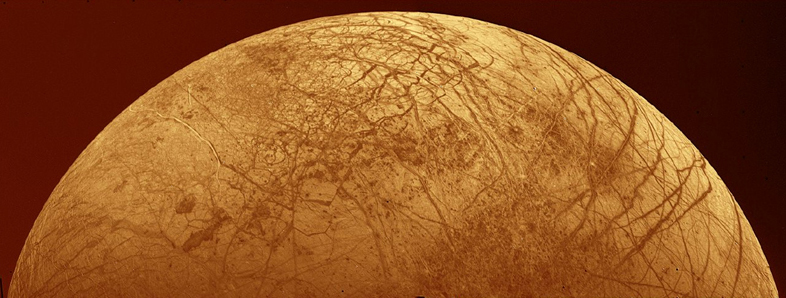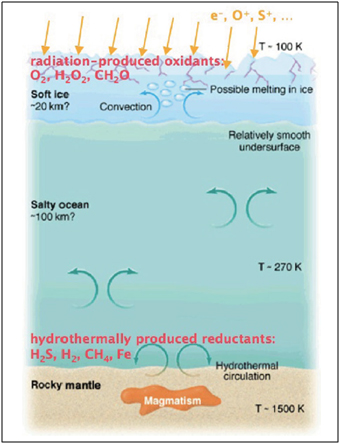
Life and the seas of Europa
Jupiter’s icy moon Europa has been of interest to astronomers for hundreds of years, and to planetary scientists since it was first imaged by the Pioneer spacecraft in the 1970s. Since then the NASA missions Voyager 1 and 2, Galileo and most recently New Horizons have all paid the moon a visit, and thanks to the remarkable high resolution imagery returned by Galileo in particular, it is possible that scientists may have uncovered the single most promising candidate for hosting astrobiology in our Solar System to date.
Europa is a moon with a difference. The smallest of the Galilean satellites, and the second most proximate to Jupiter, Europa has a surface topography matched by no known planet or moon. It is smooth and bright, and its young surface – only 40-90 million years old, is relatively devoid of significant impact craters when compared to its Jovian neighbours Ganymede and Callisto. The icy shell of Europa is pockmarked with a series of prominent crisscrossing surface features known as lineae, but also with domes, albedo features and surface ridges, all thought to be the geomorphological products of a subterranean ocean of liquid water churning slowly beneath the brittle crust. Jupiter and its extensive family of moons orbit the Sun at roughly 5 Astronomical Units (AU), a distance at which the light of our nearest star is faint and weak, and planetary surface temperatures are well below freezing. Nevertheless, it is thought that beneath Europa’s ~20km thick crust an ocean of salty liquid water exists, perhaps a hundred kilometres deep, warmed by the internal heat generated by Europa’s rapid transit around Jupiter, as well as from the gravitational interaction with its Laplace resonance partners, Ganymede and Io.
The Biogeochemistry of the Europan Ocean
The Europan ocean represents a completely unique geochemical system and a potential astrobiological repository unlike any other in our Solar System. Cut off from light and the planetary surface, the circulation of Europa’s salty subsurface ocean is most likely driven by convection from below, where heat and reductant input originates directly from the upper mantle. Oxidation products such as oxygen and hydrogen peroxide may be formed via radioactive decay within the ocean and ice shell, but also produced and deposited extensively on the surface crust via ion irradiation. These products are likely to be the Europan ocean’s main source of oxidising power, eventually penetrating the ice/ocean barrier under conditions of preferential or partial melting of the surface crust, possibly due to a localised plume of upwelling warm water from below. Ubiquitous lineae, surface ridges and ‘chaotic’ terrain on the surface of Europa are put forward as evidence of this process occurring over timescales of 10 – 100 million years. Whether a discreet boundary exists at the surface crust/ocean interface or if an intermediate layer of slushy material separates the two zones is not immediately clear.

Photosynthetic surface-dwelling life is considered extremely unlikely to exist on Europa due to high levels of magnetospheric irradiation and frigid surface temperatures of between 80 and 120 K; a very harsh environment for even the most hardy, radiation-resistant psychrophilic microorganisms. Brine deposits would not be stable anywhere on the Europan surface, further reducing the likelihood of surficial biology. However, the slightly alkaline (pH 8-9), sulphate-carbonate Europan ocean represents a relatively warm (~270 K) chemical-rich environment and easily forms the strongest candidate medium for hosting astrobiology within our Solar System.
Biogeochemical modelling studies of Europa’s ocean have been carried out over the last few years with interesting results. Tidal heating of the silicate mantle resulting from gravitational interaction with Jupiter and the other Galilean moons could produce volcanic and hydrothermal vent systems on the ocean floor analogous to those found on the seabed of the Earth. Here, potential chemotrophic microorganisms have the option of exploiting a host of different metabolic pathways, including the oxidation of methane, hydrogen, sulphur, ferrous iron and organic compounds, but also the reduction of ferric iron or by adopting anaerobic methanogenesis or acetogenesis. The link between these hypothetical exobiological processes and the geochemical cycles of carbon, iron and sulphur on Europa would, as on Earth, represent a fundamental biological recycling and feedback mechanism between geology and chemistry ultimately driven by the periodic replenishment of rocks and the steady trickle of reductant from the ocean floor.
The general consensus seems to be that whilst the Europan ocean’s chemical soup could support a putative chemoautotrophic biomass, the viability of this ecosystem is likely to be several orders of magnitude lower than what could be supported by photosynthesis. In light of this, any Europan life would most likely be very small, exhibit staggeringly low growth rates and limited motility.
The Search for Europan Life
Given the compelling evidence, several missions to Europa have been planned for the future. Some of these have unfortunately been cancelled, but perhaps the most exciting extant proposal is the Europa Jupiter System Mission – Laplace (EJSM/Laplace), a joint NASA/ESA unmanned campaign scheduled for launch in 2020, arriving at Jupiter in 2025. The EJSM will consist of two components, the Jupiter Europa Orbiter (JEO), built and operated by NASA, and ESA’s Jupiter Ganymede Orbiter (JGO). These instruments will be tasked with addressing some of the major science questions posed by the Jupiter system, but are heavily focussed on issues surrounding habitability and geochemistry. In particular, the objectives of the JEO instrument are centred on determining the chemistry and geology of Europa’s ice shell, its ocean and any ocean/mantle interactions. To do this JEO is equipped with a suite of 11 instruments, including ice penetrating radar, visible-infrared and UV imaging spectrometers, an ion and neutral mass spectrometer, several cameras, a magnetometer and a thermal instrument.
Orbital observation missions like EJSM are unlikely to be able to conclusively solve the puzzle of potential Europan biology, but they will provide more information on the geochemistry of this unusual moon and by implication improve our understanding of its potential habitability. Definitively answering this most pressing of questions may be out of the reach of contemporary or near-future exploratory technology. Some extremely imaginative proposals have been suggested, such as the Nuclear Europa Mobile Ocean (NEMO) mission. NEMO would consist of a lander and autonomous underwater vehicle termed a ‘hydrobot’ that would be deployed directly into the Europan subterranean ocean. However, contamination of the subsurface ocean is a serious concern, and the technological and budgetary hurdles that would need to be overcome for this mission to be successful essentially rule out any possibility of its inception in the foreseeable future.
The mysterious oceans of Europa, and any of its potential inhabitants, will most likely remain out of reach of science for some decades to come, but the attraction of this icy, scarred moon is undeniable. Europa is the first step on the long road to a better understanding the outer planets and their many diverse moons and, in terms of astrobiological potential, Europa is unmatched in our Solar System. It will therefore form the focus of many more mission proposals with habitability and biological detection at their core in the future. It is an exciting, if frustrating, time to be working in this area of science, but I believe that the secrets that this moon may have to offer will be worth the wait, no matter how long it takes.
References:
NASA (2011). Europa Jupiter System Mission (EJSM) [Online]. Available here. (Last accessed on 25th January 2012)
Pappalardo, R. T. (2010). Seeking Europa’s Ocean. Galileo’s Medicean Moons: their impact on 400 years of discovery. Proceedings of IAU Symposium No. 269, 2010 pp. 101 – 114
Schmidt, B.E., Blankenship, D.D., Patterson, G.W. and Schenk, P.M. (2012). Active formation of ‘chaos terrain’ over shallow subsurface water on Europa. Nature. 479 pp. 502 – 505
Zolotov, M. Y and Shock, E. L (2004). A model for low-temperature biogeochemistry of sulfur,carbon, and iron on Europa. Journal of Geophysical Research 109 E06003
